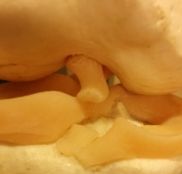Dextrose Tightens Loose ACL Ligament by Simple Injection
Reeves et al 2003
Reeves KD Hassanein K Long term effects of dextrose prolotherapy for anterior cruciate ligament laxity: A prospective and consecutive patient study. Alt Ther Hlth Med May-Jun 2003, 9(3): p58-62.
Dr. Reeves' Notes: The "method" for this study was that 16 knees with machine measured ACL laxity (KT-1000 arthrometer) were injected bimonthly with 10-25% dextrose solution for 1 year and then an average of 4 times yearly thereafter until 3 year follow-up. Summary: Using simple dextrose injection into 16 knees with a loose ACL ligament, 10/16 knees were no longer loose by machine measurement at time of follow-up, and symptoms were improved. Symptom of osteoarthritis improved even in those who still tested loose. At the 3 year follow-up pain with walking had improved by 43% , subjective swelling improved 63%, flexion range of motion improved by 10.5 degrees, and KT1000 ADD (machine measure of ACL ligament looseness) improved by 71%.
Reeves KD Hassanein K Long term effects of dextrose prolotherapy for anterior cruciate ligament laxity: A prospective and consecutive patient study. Alt Ther Hlth Med May-Jun 2003, 9(3): p58-62.
Dr. Reeves' Notes: The "method" for this study was that 16 knees with machine measured ACL laxity (KT-1000 arthrometer) were injected bimonthly with 10-25% dextrose solution for 1 year and then an average of 4 times yearly thereafter until 3 year follow-up. Summary: Using simple dextrose injection into 16 knees with a loose ACL ligament, 10/16 knees were no longer loose by machine measurement at time of follow-up, and symptoms were improved. Symptom of osteoarthritis improved even in those who still tested loose. At the 3 year follow-up pain with walking had improved by 43% , subjective swelling improved 63%, flexion range of motion improved by 10.5 degrees, and KT1000 ADD (machine measure of ACL ligament looseness) improved by 71%.
ABSTRACT
OBJECTIVE: Determine the 1 and 3 year efficacy of dextrose injection prolotherapy on anterior cruciate ligament (ACL) laxity. After year 1, determine patient tolerance of a stronger dextrose concentration (25% versus 10%).
DESIGN: Prospective consecutive patient trial.
SETTING: Outpatient physical medicine clinic.
PATIENTS OR OTHER PARTICIPANTS: Eighteen patients with 6 months or more of knee pain plus ACL knee laxity. This laxity was defined by a KT1000 anterior displacement difference (ADD) of 2 mm or more.
INTERVENTION: Intraarticular injection of 6-9 cc of 10% dextrose at months 0, 2, 4, 6, and 10. Injection with 6 cc of 25% dextrose at 12 months. Then, depending on patient preference, injection of either 10% or 25% dextrose every 2-4 months (based on patient preference) through 36 months.
MAIN OUTCOME MEASURES: Visual analogue scale (VAS) for pain at rest, pain on level surfaces, pain on stairs, and swelling. Goniometric flexion range of motion, and KT1000-measured ADD were also measured. All measurements were obtained at 0, 6, 12 and 36 months.
RESULTS: Two patients did not reach 6 month data collection, 1 of whom was diagnosed with disseminated cancer. The second was wheelchair-bound and found long-distance travel to the clinic problematic. Sixteen subjects were available for data analysis. KT1000 ADD, measurement indicated that 6 knees measured as normal (not loose) after 6 months, 9 measured as normal after 1 year (6 injections), and 10 measured as normal at 3 years. At the 3 year follow-up, pain at rest, pain with walking, and pain with stair use had improved by 45%, 43%, and 35% respectively. Individual paired t tests indicated subjective swelling improved 63% (P = .017), flexion range of motion improved by 10.5 degrees (P = .002), and KT1000 ADD improved by 71% (P = .002). Eleven out of 16 patients preferred 10% dextrose injection.
CONCLUSION: In patients with symptomatic anterior cruciate ligament laxity, intermittent dextrose injection resulted in clinically and statistically significant improvement in ACL laxity, pain, swelling, and knee range of motion.
DESIGN: Prospective consecutive patient trial.
SETTING: Outpatient physical medicine clinic.
PATIENTS OR OTHER PARTICIPANTS: Eighteen patients with 6 months or more of knee pain plus ACL knee laxity. This laxity was defined by a KT1000 anterior displacement difference (ADD) of 2 mm or more.
INTERVENTION: Intraarticular injection of 6-9 cc of 10% dextrose at months 0, 2, 4, 6, and 10. Injection with 6 cc of 25% dextrose at 12 months. Then, depending on patient preference, injection of either 10% or 25% dextrose every 2-4 months (based on patient preference) through 36 months.
MAIN OUTCOME MEASURES: Visual analogue scale (VAS) for pain at rest, pain on level surfaces, pain on stairs, and swelling. Goniometric flexion range of motion, and KT1000-measured ADD were also measured. All measurements were obtained at 0, 6, 12 and 36 months.
RESULTS: Two patients did not reach 6 month data collection, 1 of whom was diagnosed with disseminated cancer. The second was wheelchair-bound and found long-distance travel to the clinic problematic. Sixteen subjects were available for data analysis. KT1000 ADD, measurement indicated that 6 knees measured as normal (not loose) after 6 months, 9 measured as normal after 1 year (6 injections), and 10 measured as normal at 3 years. At the 3 year follow-up, pain at rest, pain with walking, and pain with stair use had improved by 45%, 43%, and 35% respectively. Individual paired t tests indicated subjective swelling improved 63% (P = .017), flexion range of motion improved by 10.5 degrees (P = .002), and KT1000 ADD improved by 71% (P = .002). Eleven out of 16 patients preferred 10% dextrose injection.
CONCLUSION: In patients with symptomatic anterior cruciate ligament laxity, intermittent dextrose injection resulted in clinically and statistically significant improvement in ACL laxity, pain, swelling, and knee range of motion.
